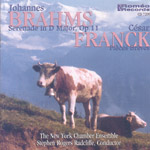It’s possible that Brahms originally composed his 1858 Serenade No. 1 as a nonet for winds and strings. Alan Boustead’s reconstruction of the first version is in large part speculation, as Brahms left only the final full-orchestra score. While it’s impossible to compare this later incarnation to the composer’s first thoughts, the evidence here suggests that Brahms made the right decision in re-scoring this sprawling, six-movement work. A diminished sonic amplitude is apparent right from the start, as the chamber group–especially without the trumpets and timpani–cannot be expected to match an orchestra’s dynamic range. However, the reduced numbers do yield an extra clarity that allows you to become better acquainted with the score’s inner details. The most successful movements are the more intimate, smaller-scaled II, III, and IV. It’s in the big “outdoor” movements–I, V, and VI–that you feel the music needs more “room”.
The New York Chamber Ensemble, under Stephen Rogers Radcliffe’s agile, flowing direction, persuasively meets the score’s formidable challenges. While it certainly won’t replace Haitink’s lush Concertgebouw recording, or Kertész’s taut, athletic reading with the London Symphony, this chamber version offers an opportunity to get a fresh take on Brahms’ early triumph. It’s a pity Romeo’s recording isn’t as accommodating, suffering as it does from closely-miked sound that becomes glaring in tutti passages.
In 1890, the year before his death, César Franck composed a book of 55 Pièces Brèves for organ, of which Henri Busser arranged eight for chamber ensemble. The three presented here are charming, easy-going works that, while displaying nothing of the passionate rhapsody that characterizes the composer’s symphony, serve as a light appetizer before the more substantive Brahms.
































